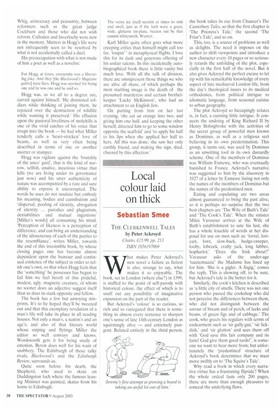Local colour laid on thick
Sebastian Smee
THE CLERKFNWELL TALES by Peter Ackroyd Chatto, £15.99, pp, 213 ISBN 1856197069 What makes Peter Ackroyd's new novel a failure as fiction is also, strange to say, what makes it so enjoyable. The book, set in London (where else?) in 1399, is stuffed to the point of self-parody with historical colour, the effect of which is to snuff out any possibility of imaginative expansion on the part of the reader.
But Ackroyd's 'colour' is so curious, so rich and so variegated that there is something in almost every sentence to sharpen one's sense of late 14th-century London as squirmingly alive — and extremely pungent. Related entirely in the third person, the book takes its cue from Chaucer's The Canterbury Tales, so that the first chapter is The Prioress's Tale,' the second 'The Friar's Tale', and so on.
This, too, is a source of problems as well as delights. The need it imposes on the author to shift viewpoints and introduce a new character every 10 pages or so seriously retards the unfolding of the plot, especially in the first half of the novel. But it also gives Ackroyd the perfect excuse to let rip with his remarkable knowledge of every aspect of late mediaeval London life, from the day's theological issues to its medical orthodoxies, from political intrigue to idiomatic language, from seasonal cuisine to urban geography.
The plot Ackroyd so hiccupingly relates is, in fact, a cunning little intrigue. It connects the undoing of King Richard II by Henry Bolingbroke with the activities of the secret group of powerful men known as Dominus, as well as a religious sect believing in its own predestination. This group, it turns out, was used by Dominus as an unwitting tool in its own dastardly scheme. One of the members of Dominus was William Exmewe, who was eventually banished to France. Ackroyd's narrative was suggested to him by the discovery in 1927 of a letter by Extnewe listing not only the names of the members of Dominus but the names of the predestined men.
Eating and copulating are two areas almost guaranteed to bring the past alive, so it is perhaps no surprise that the two best chapters are 'The Wife of Bath's Tale' and 'The Cook's Tale'. When the sinister Miles Vavasour arrives at the Wife of Bath's establishment to sate his lust, she has a whole knuckle of words at her disposal for use on men such as: lorrel, loricart, lowt, slow-back, hedge-creeper, looby, lobcock. crafty jack, long lubber, hophariot."Does she frisk about?' Vavasour asks of the under-age `tuzziemuzzie' the Madame has lined up for him. 'She is a gigiet. A fisgig,' comes the reply. This is showing off, to be sure, but Ackroyd's tale is the better for it.
Similarly, the cook's kitchen is described as 'a little city of smells. There was not one person who passed the cookshop who did not perceive the differences between them, who did not distinguish between the savour of bream and of perch, of leeks and beans, of green figs and of cabbage.' The cook, who greets his regulars with terms of endearment such as 'sir gully-gut,' sir lickdish,' and 'sir glutton' and sees them off with 'God save this fair company and its farts! God give them good turds!', is someone we want to hear more from; but unfortunately the 'predestined' structure of Ackroyd's book determines that we must move swiftly on to 'The Squire's Tale'.
Why read a book in which every narrative virtue has a frustrating flipside? When the whole ordeal lasts only 200 pages, there are more than enough pleasures to conceal the underlying flaws.


































































 Previous page
Previous page